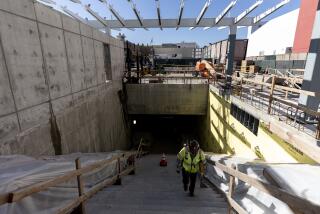Rail Revival Is a Terminal Condition in Boston
Not long ago, Boston’s South Station looked like a haunted house. Long dark corridors snaked through it. Pigeons roosted in its perpetual twilight, secure in the near-abandoned upper reaches of this massive granite structure. The old train station was a grimy and gloomy portal for travelers arriving in Beantown.
The situation seemed beyond hope. Respected planners pronounced that the depot would be easier to demolish than renovate.
South Station got a reprieve from the wrecker’s ball in 1975 when the distinctive architecture of Head House, the terminal’s main building, earned it a spot on the National Register of Historic Places.
Now the station is in the final stages of an $80-million make-over and, thanks to a railroad renaissance, on its way to a future as Boston’s transportation hub.
Federal Money Helping
Like several other train stations in the Northeast, including terminals in Hartford and New Haven, Conn.; New York City; Wilmington, Del., and Washington, South Station is benefiting from its share of $2.2 billion of federal money earmarked to improve the Northeast railway infrastructure.
Under the auspices of the Northeast Corridor Improvement Project, stations are being renovated, and tracks, bridges, tunnels and catenary (the overhead wire system that powers today’s trains) are being improved and repaired.
The newly renovated Boston station preserves the neoclassical revival architectural style that wowed travelers passing through the portals of what may once have been the country’s busiest railway terminal. In 1916, nearly twice as many travelers passed through South Station as through Grand Central.
Like Grand Central, South Station was built as a double-decker station; trains arrive and depart from two levels.
Upon completion, the renovated terminal will also feature direct road access to the Massachusetts Turnpike, a bus station and shuttle service to Logan Airport. Basic renovation to the station itself should be completed this fall, developers said. New road accesses and the bus station will be built later.
The reborn South Station will serve as more than a transportation center. Everything from fresh croissants to gourmet-to-go meals will be available in a two-story food hall inside the station. Restaurants, shops and kiosks selling flowers, newspapers and magazines will also be built in the newly enclosed Grand Concourse, once an open-air platform nearly the size of a football field.
Developers behind Boston’s South Station project say they do not expect tourists to flock to the new station, though shopping and restaurant facilities will attract office workers from nearby financial, retail and leather districts, as well as residents of the Ft. Point Channel and Chinatown areas.
“This is really part of the growing downtown business district,” said Robert Flack, senior project manager for the Beacon Cos., developers of the South Station renovation. Besides, he said, tourists would not easily be lured away from the popular shops and restaurants of the historic Faneuil Hall area.
More than any other single factor, the increasing popularity and practicality of railroading has put South Station back on track as a transportation center.
Taking the train has become an enticing option for commuters tired of battling Boston’s semi-permanent gridlock and fed up with the hopeless quest for a downtown parking space.
In the last three years, Flack says, the number of commuters opting to take the train has doubled to more than 15,000 daily. And he says that number is expected to double again by the mid-1990s.
Amtrak is booming, too. Ridership beat all records in the 1988 fiscal year as the company posted its first billion-dollar-plus year. And in 1989, ridership may be even higher. Amtrak can hardly keep pace with the increased demand.
“We’re splitting at the seams,” Amtrak spokesman Clifford Black said. “We just don’t have the space to handle all the people who want to ride.”
Amtrak has always attracted plenty of riders in the Northeast, particularly business people shuttling between cities such as Philadelphia, New York, Boston and Washington.
Distance Demand Growing
In the last three or four years, there also has been an unprecedented demand for long-distance travel. Low-priced package deals made train travel more appealing to vacationers, said Marian Jordan, a travel agent at Executive Travel in Newington, Conn. Now passengers hoping for a berth in a sleeping car should make reservations months in advance, she said.
Increased air fares and Amtrak’s new and more user-friendly schedule sent ridership soaring, U.S. Travel Data spokeswoman Julie Bowers said. And, she said, “they’ve done a heck of a lot of advertising; that can’t hurt.”
Black attributes the ridership resurgence to increasing disenchantment with airlines and frustration with crowded highways. In trains, he said, passengers are free to move around, socialize or simply contemplate the scenery.
Whatever their reasons, travelers are rediscovering America’s railroads. Renovated terminals such as South Station add their own allure to riding the rails.
More to Read
Sign up for The Wild
We’ll help you find the best places to hike, bike and run, as well as the perfect silent spots for meditation and yoga.
You may occasionally receive promotional content from the Los Angeles Times.






